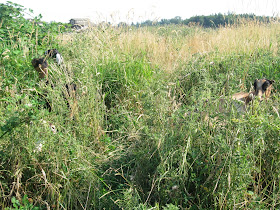
The end of July, and already it's been a long hot summer. I think the heat may have peaked yesterday (at 101 degrees!!!) but it's not really going to cool down to what we might call normal temperatures anytime soon. And as far as I know, there's no rain in the forecast at all. In fact, I remember hearing that the long-term forecast was for "drier than normal" conditions right through september.
I hope that doesn't mean no rain at all. There was a thunderstorm about a week ago, with enough rain to spoil all the hay in the fields, but aside from that, nothing since May, and not much then. The grass is dry and dead looking. The trees all look droopy and tired, even old well-established trees. Blackberries are doing fine, though. Clover is still mostly green. And, not surprisingly, thriving are the thistles. That's my back field at the top of the page: pretty much a sea of thistles. If anyone out there is doing a survey of the types of thistles that grow in Whatcom County, well, you're invited. They're all here, I'm sure.
At least the honeybees like them. That's the one good thing about thistles I can think of.
How many goats can you find in this picture? Hint: four.
Homero got the mower working. He managed to mow the front lawn and the back lawn where the playset is, and I think he even got around the fruit trees. First time we've managed to mow without it breaking down in the middle since early spring. Hooray!
But I'm not going to try it against the thistles. I know which side would win that confrontation!



Good old Canada thistle...
ReplyDeleteIt has spread across most of Alberta over the last 40 years or so. Nasty stuff indeed. The cheap/high exercise method of controlling them is buying a scythe and cutting them down, particularly just before a good rain. We have a gas powered bladed weed whacker to cut ours down (some of it anyway). Then one has to plow (or dig) up the roots and disk (chop) the bejeesus out of them. They have to be chopped up well and let to dry out (or be drowned out if it is raining long and hard enough). The bastards LOOOOVE to spread via roots.
Apparently donkeys like to eat them though.